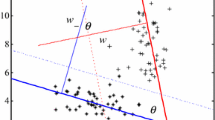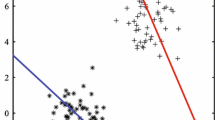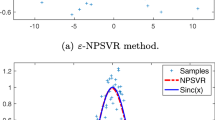Abstract
Support vector machine (SVM) has attracted substantial interest in the community of machine learning. As the extension of SVM, nonparallel hyperplane SVM (NHSVM) classification algorithms have become current researching hot spots in machine learning during the last few years. For binary classification tasks, the idea of NHSVM algorithms is to find a hyperplane for each class, such that each hyperplane is proximal to the data points of one class and far from the data points of the other class. Compared with the classical SVM, NHSVM algorithms have lower computational complexity, work better on XOR problems and can get better generalization performance. This paper reviews three representative NHSVM algorithms, including generalized eigenvalue proximal SVM (GEPSVM), twin SVM (TWSVM) and projection twin SVM (PTSVM), and gives the research progress of them. The aim of this overview is to provide an insightful organization of current developments of NHSVM algorithms, identify their limitations and give suggestions for further research.

Similar content being viewed by others
References
Chen XB, Yang J, Ye QL, Liang J (2011) Recursive projection twin support vector machine via within-class variance minimization. Pattern Recogn 44(10–11):2643–2655
Chen WJ, Shao YH, Ning H (2013) Laplacian smooth twin support vector machine for semi-supervised classification. Int J Mach Learn Cyber. doi:10.1007/s13042-013-0183-3
Cong HH, Yang CF, Pu XR (2008) Efficient speaker recognition based on multi-class twin support vector machines and GMMs. 2008 IEEE conference on robotics, automation and mechatronics, pp 348–512
Cristianini N, Taylor JS (2004) An introduction to support vector machines and other kernel-based learning methods (trans: Li G, Wang M, Zeng H). Publishing House of Electronics Industry, Beijing
Ding SF, Hua XP (2013) Recursive least squares projection twin support vector machines for nonlinear classification. Neurocomputing. doi:10.1016/j.neucom.2013.02.046
Ding SF, Yu JZ, Qi BJ, Huang HJ (2012) An overview on twin support vector machines. Artif Intell Rev. doi:10.1007/s10462-012-9336-0
Ding SF, Qi BJ, Tan HY (2011) An overview on theory and algorithm of support vector machines. J Univ Electron Sci Technol China 40(1):2–10
Ding XJ, Zhang GL, Ke YZ, Ma BL, Li ZC (2008) High efficient intrusion detection methodology with twin support vector machines, pp 560–564. doi:10.1109/ISISE.2008.278
Fung G, Mangasarian OL (2001) Proximal support vector machine classifiers. In: Proceedings of the 7th ACMSIFKDD international conference on knowledge discovery and data mining, pp 77–86
Ghorai S, Mukherjee A, Dutta PK (2009) Nonparallel plane proximal classifier. Signal Process 89:510–522
Guarracino MR, Cifarelli C, Seref O, Pardalos PM (2007) A classification method based on generalized eigenvalue problems. Optim Method Softw 22(1):73–81
Hua XP, Ding SF (2012) Matrix pattern based projection twin support vector machines. Int J Digit Content Technol Appl 6(20):172–181
Huang HJ, Ding SF, Shi ZZ (2013) Primal least squares twin support vector regression. J Zhejiang Univ SCI C 14(9):722–732
Jayadeva, Khemchandni R, Chandra S (2007) Twin support vector machines for pattern classification. IEEE Trans Pattern Anal Mach Intell 29(5):905–910
Jayadeva, Khemchandai R, Chandra S (2007) Fuzzy multi-category proximal support vector classification via generalized eigenvalues. Soft Comput 11(7):685–769
Khan NM, Ksantini R, Ahmad IS, Boufama B (2012) A novel SVM plus NDA model for classification with an application to face recognition. Pattern Recogn 45(1):66–79
Khemchandani R, Jayadeva, Chandra S (2009) Optimal kernel selection in twin support vector machines. Optim Lett 3(1):77–88
Kumar MA, Gopal M (2009) Least squares twin support vector machines for pattern classification. Expert Syst Appl 36(4):7535–7543
Lin KB, Wang ZJ (2006) The method of fax receiver’s name recognition based on SVM. Comput Eng Appl 42(7):156–158
Liu XL, Ding SF (2010) Appropriateness in applying SVMs to text classification. Comput Eng Sci 32(6):106–108
Mangasarian OL, Wild EW (2006) Multisurface proximal support vector machine classification via generalized eigenvalues. IEEE Trans Pattern Anal Mach Intell 28(1):69–74
Mozafari K, Nasiri JA, Charkari NM, Jalili S (2011) Action recognition by space-time features and least squares twin SVM. 2011 first international conference on informatics and computational intelligence, pp 287–292
Naik GR, Kumar DK, Jayadeva (2010) Twin SVM for gesture classification using the surface electromyogram. IEEE Trans Inf Technol Biomed 14(2):301–308
Peng XJ (2010) TSVR: an efficient twin support vector machine for regression. Neural Netw 23(3):365–372
Peng XJ (2010) Primal twin support vector regression and its sparse approximation. Neurocomputing 73(16–18):2846–2858
Peng XJ (2011) Building sparse twin support vector machine classifiers in primal space. Inf Sci 181:3967–3980
Peng XJ, Xu D (2012) Twin Mahalanobis distance-based support vector machines for pattern recognition. Inf Sci 200(10):22–37
Peng XJ, Xu D (2013) Bi-density twin support vector machines for pattern recognition. Neurocomputing 99:134–143
Peng XJ, Xu D (2013) Robust minimum class variance twin support vector machine classifier. Neural Comput Appl 22:999–1011
Peng XJ, Xu D (2013) Norm-mixed twin support vector machine classifier and its geometric algorithm. Neurocomputing 99:486–495
Peng XJ, Wang YF, Xu D (2013) Structural twin parametric-margin support vector machine for binary classification. Knowl-Based Syst 49:63–72
Qi ZQ, Tian YJ, Shi Y (2012) Laplacian twin support vector machine for semi-supervised classification. Neural Netw 35:46–53
Qi ZQ, Tian YJ, Shi Y (2013) Robust twin support vector machine for pattern classification. Pattern Recogn 46(1):305–316
Qi ZQ, Tian YJ, Shi Y (2013) Structural twin support vector machine for classification. Knowl-Based Syst 43:74–81
Shao YH, Chen WJ, Huang WB, Yang ZM, Deng NY (2013) The best separating decision tree twin support vector machine for multi-class classification. Procedia Comput Sci 17:1032–1038
Shao YH, Deng NY (2013) A novel margin-based twin support vector machine with unity norm hyperplanes. Neural Comput Applic 22(7–8):1627–1635
Shao YH, Deng NY, Yang ZM (2012) Least squares recursive projection twin support vector machine for classification. Pattern Recogn 45(6):2299–2307
Shao YH, Wang Z, Chen WJ, Deng NY (2013) A regularization for the projection twin support vector machine. Knowl-Based Syst 37:203–210
Shao YH, Zhang CH, Yang ZM, Jing L, Deng NY (2013) An ε-twin support vector machine for regression. Neural Comput Applic 23(1):175–185
Si X, Jing L (2009) Mass detection in digital mammograms using twin support vector machine-based CAD system. 2009 WASE international conference on information engineering, pp 240–243
Singh M, Chadha J, Ahuja P, Jayadeva, Chandra S (2011) Reduced twin support vector regression. Neurocomputing 74(9):1471–1477
Vapnik VN (2000) The nature of statistical learning theory (trans: Zhang X). Tsinghua University Press, Beijing
Vapnik VN (2004) Statistical learning theory (trans: Xu J, Zhang X). Publishing House of Electronics Industry, Beijing
Wang YN, Zhao X, Tian YJ (2013) Local and global regularized twin SVM. Procedia Comput Sci 18:1710–1719
Wang Z, Shao YH, Wu TR (2013) A GA-based model selection for smooth twin parametric-margin support vector machine. Pattern Recogn 46:2267–2277
Xie SQ, Shen FM, Qiu XN (2009) Face recognition using support vectormachines. Comput Eng 35(16):186–188
Xu YT, Wang LS (2012) A weighted twin support vector regression. Knowl-Based Syst 33:92–101
Xu YT, Wang LS, Zhong P (2012) A rough margin-based v-twin support vector machine. Neural Comput Applic 21(6):1307–1317
Yang CF, Ji LP, Liu GS (2009) Study to speech emotion recognition based on TWINsSVM. 2009 Fifth international conference on natural computation, pp 312–316
Yang XB, Chen SC (2006) Proximal support vector machine based on prototypal multiclassification hyperplanes. J Comput Res Dev 43(10):1700–1705
Ye QL, Zhao CX, Gao SB, Zheng H (2012) Weighted twin support vector machines with local information and its application. Neural Netw 35:31–39
Ye QL, Zhao CX, Ye N, Chen XB (2011) Localized twin SVM via convex minimization. Neurocomputing 74(4):580–587
Ye YF, Cao H, Bai L, Wang Z, Shao YH (2013) Exploring determinants of inflation in China based on L 1-ε-twin support vector regression. Procedia Comput Sci 17:514–522
Zhao YP, Zhao J, Zhao M (2013) Twin least squares support vector regression. Neurocomputing 118:225–236
Acknowledgments
This work was supported in part by the National Key Basic Research and Development Program (973 Program) under Grant No. 2013CB329502, the National Natural Science Foundation of China under Grant No. 61379101 and the Natural Science Foundation of Jiangsu Province under Grant No. BK2011417.
Author information
Authors and Affiliations
Corresponding author
Rights and permissions
About this article
Cite this article
Ding, S., Hua, X. & Yu, J. An overview on nonparallel hyperplane support vector machine algorithms. Neural Comput & Applic 25, 975–982 (2014). https://doi.org/10.1007/s00521-013-1524-6
Received:
Accepted:
Published:
Issue Date:
DOI: https://doi.org/10.1007/s00521-013-1524-6




